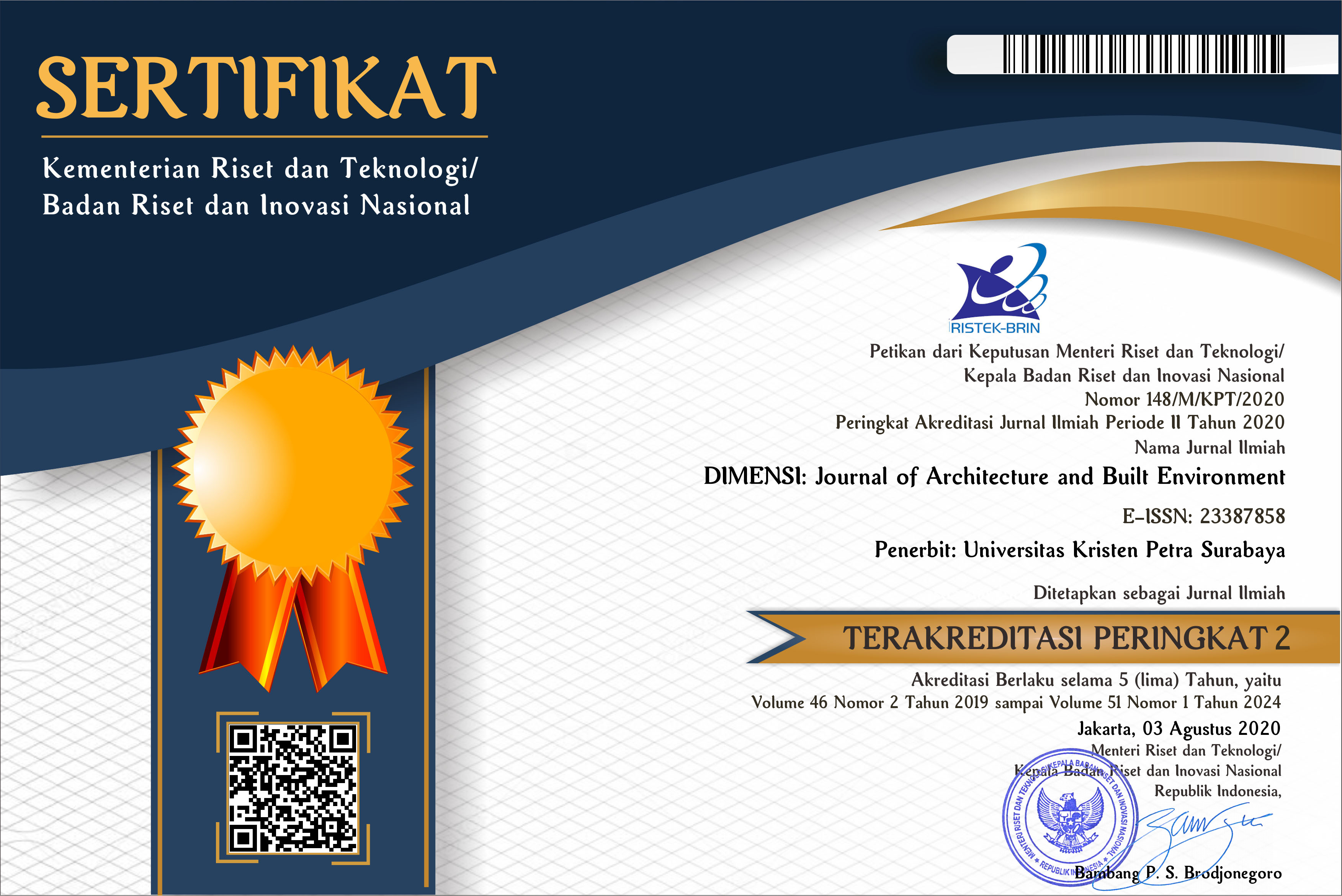THE APPLICATION OF EVIDENCE BASED DESIGN IN EMERGENCY ROOM OF PUBLIC HOSPITAL OF DR. R. SOSODORO DJATIKOESOEMO BOJONEGORO
 :
:
https://doi.org/10.9744/dimensi.42.1.15-24
Keywords:
Facilities and Management Safety (FMS), EBD, BenchmarkingAbstract
The Hospital facilities built under Evidence Based Design (EBD) will create a safe and comfortable environment, lower the nosocomial infection, quicken the patient recovery, lower the treatment cost, and improve staffs’ performance. The emergency room of public hospital of Dr.R.Sosodoro Djatikoesoemo Bojonegoro needs to be redesigned because the existing design does not meet physical safety. The reparation should refer to Facilities and Safety Management (FMS), Indonesian regulation, EBD concept and benchmarking to RSCM Jakarta considered as an application sample. This research applies case study with descriptive single case study design. The result of the research shows that reparation should be done that includes site and location, building components, and rooms lay out. The width of the rooms should meet minimal standard. The placing of triage room and resuscitation should be in the front area. Sinks should be located near the entrance of every room. The isolation and decontamination rooms should be provided.Downloads
References
Angenent et al. (2005). Molecular identification of potential pathogens in water and air of a hospital therapy pool. Proceedings of the National Academy of Sciences of the United States of America, 102(13), 4860–4865.
Benchmarking, Higher European & Education (2008). Critical successful factors for effective benchmarking. http://www.education-benchmarking.org/critical-successful-factors-for-effective benchmarking.html.
Burns, K., Burrows, J., Chris, M., and Nirenberg, L. (2004). Hospital Emergency Room Ergonomic Evaluations & Recommendations. Cornel Ergonomic Consultant.
Burns, K., Burrows, J., Moe, C. And Nirenberg, L. (2004). Hospital Emergency Room Ergonomic Evaluations & Recommendations. Cornel Ergo-nomic Consultant.
Carpman, J. R., Grant, M., and Simmons, D. (1984). No more mazes: Research about design for wayfinding in hospitals. Ann Arbor, Michigan: The University of Michigan Hospitals.
Cochrane, P., Nishimura, J., Spencer, G. and Taylor, E. (2012). Improving Staff Outcomes in Inpatient Units—A Canadian Context. http://www. healthcaredesignmagazine.com/article/improving-staff-outcomes-inpatient-units-canadian-context.
Conger, N. G. et al. (2004). Mycobacterium simiae outbreak associated with a hospital water supply. Infection Control and Hospital Epidemiology, 25(12), 1050–1055.
Heudorf, U., Hentschel,W., Kutzke, G., Pfetzing, H. and Voigt, K. Hygienic procedures in operation theatres--guidelines and reality. Data obtained on hygiene control measures by public health service at Frankfurt am Main. Article in German. http://www.ncbi.nlm.nih.gov/pubmed/12772073. Diakses April 2014.
Malenbaum, Sara, Keefe, Francis J, Williams, Amanda, Ulrich, Roger Somers, Tamara J. (2009). Pain in its Environmental Context: Implications for Designing Environments to Enhance Pain Control. NIH Public Acces, 134(3), 241–244.
Mineshita, M., Nakamori, Y., Seida, Y., and Hiwa¬tashi, S. (2005). Legionella pneumonia due to exposure to 24-hour bath water contaminated by Legionella pneumophila serogroup-5. Internal Medicine, 44(6), 662–665.
Noskin, G.A., Peterson, L.R. and Nightingale, F. (2001). Engineering Infection Control through Facility Design. Emerging Infection Desease, 7(2), 354–357.
Saint, A. (2010). Center for Advanced Healing Evidence Based Design Study Saint Alphonsus Regional Medical Center Boise, Idaho. http://www.saintalphonsus.org/centerforadvancedhealing_design.html.
Soesanto, R. K. (2012). Pengaruh Koridor yang Tidak Sesuai Standar terhadap Keamanan dan Kenyamanan Proses Pentrasferan Pasien di RSUP Dr. R. Soetrasno Rembang.
Ulrich, R. S. et al. (2008). A Review of The Research Literature on Evidence Based Healthcare design. Healthcare Leadership.
Downloads
Published
How to Cite
Issue
Section
License
Authors who publish with this journal agree to the following terms:
- Authors retain copyright and grant the journal right of first publication with the work simultaneously licensed under a Creative Commons Attribution License that allows others to share the work with an acknowledgement of the work's authorship and initial publication in this journal.
- Authors are able to enter into separate, additional contractual arrangements for the non-exclusive distribution of the journal's published version of the work (e.g., post it to an institutional repository or publish it in a book), with an acknowledgement of its initial publication in this journal.
- Authors are permitted and encouraged to post their work online (e.g., in institutional repositories or on their website) prior to and during the submission process, as it can lead to productive exchanges, as well as earlier and greater citation of published work (See The Effect of Open Access).

















